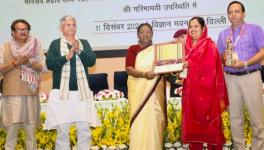Dalit and Muslim Children More Vulnerable to Stunting, Shows Study

India is home to nearly one-third of stunted children, who are under five years with their height relative to their age below the acceptable global range, in the world. According to a recent study, children from Scheduled Castes (SCs), Scheduled Tribes (STs), Other Backward Classes (OBCs) and Muslim families, who are vulnerable to social discrimination, are more likely to be stunted.
According to the study, the average incidence of stunting in India is higher compared to the average of 30 countries in Sub-Saharan Africa (SAA). The study, titled ‘The Missing Piece of the Puzzle: Caste Discrimination and Stunting’, has been written by Ashwini Deshpande of Ashoka University’ Center for Economic Data and Analysis and Rajesh Ramachandran of the University of Heidelberg.
The study aimed to understand the impact of caste and socioeconomic factors on stunted children. It revealed a pattern not discussed before—the height disadvantage in all groups in India, other than upper-caste (UC) Hindus, is higher compared to the children in SSA.
The rate of stunting among UC Hindu children is lower at 26% compared to 31% in SSA. But the rate of stunting among SC-ST, OBC and Muslim children is much higher at 40%, 36% and 35% respectively. Thus, SC-ST, OBCs and UC-Muslim children are 14, 10 and 9 percentage points, or 35-50%, more likely to be stunted compared to UC-Hindu children.
“In other words, the gaps in child heights between the social groups in India are two-to-three times greater than the India-SSA child height gap. The entire India-SSA child height gap is accounted for by the lower child heights of disadvantaged groups,” the study pointed out.
“The question ‘Why are Indian children shorter than African children?’ needs to be rephrased to ‘Why are the gaps in child height between social groups within India so high?’” it further stated.
The authors identified five important factors that affect child height: (i) lack of access to sanitation, captured by two variables: no household access to toilet facility and household members defecating in a bush/field; and the exposure of a household to open defecation at the primary sampling unit level; (ii) the mother’s human capital, measured by two indicators: years of schooling and ability to read measured by an actual test; (iii) mother’s anthropometric status as captured by the height-for-age (HFA)-Z score and the weight-for-height (WFH)-Z score and age; (iv) asset differences as captured by the wealth index factor score; and (v) intra-household allocation and fertility decisions, proxied by birth order and sibling size.
“We find large inter-group differences in the covariates that affect child height, especially between UC-Hindus and SC-STs. To highlight a few, 58% of SC-ST households have no access to a toilet facility and defecate in a bush/field compared to 23% UC-Hindus; maternal literacy is 83% for UC-Hindus compared to 51% for SC-STs; SC-ST mothers have 5.26 years of schooling compared to 9.47 for UC-Hindu mothers; and the average HFA Z-score of UC-Hindu mothers is -1.82 compared to -2.15 for SC-ST mothers,” the study further stated.
The authors raised a very important question. “Clearly, there are large and significant differences in the environment that upper-caste and Dalit children grow up with the circumstances being much more adverse for Dalit and Adivasi (SC-ST) children. Do these differences in socio-economic characteristics explain the child height gap between social groups?”
The authors suggest that the gaps between UC Hindus and Dalit (SC) children is affected by societal discrimination, manifested in the illegal but widespread practice of untouchability. Dalit children’s height disadvantage increases in districts where the self-reported practice of untouchability is higher. They used data from India Human Development Survey (IHDS 2012) to estimate the association between the practice of untouchability and child height.
The results show that the caste gaps in child height are not entirely a reflection of class or socioeconomic status differences, the study concluded. “In particular, variation in the practice of untouchability does not affect the height of upper-caste children, but the higher spread of untouchability-related practices is associated with lower heights of Dalit children. The results, moreover, suggest a role for discriminatory practices in affecting service delivery to pregnant and nursing mothers from stigmatised groups and consequently the health outcomes of lower caste children,” the authors said.
Get the latest reports & analysis with people's perspective on Protests, movements & deep analytical videos, discussions of the current affairs in your Telegram app. Subscribe to NewsClick's Telegram channel & get Real-Time updates on stories, as they get published on our website.
























